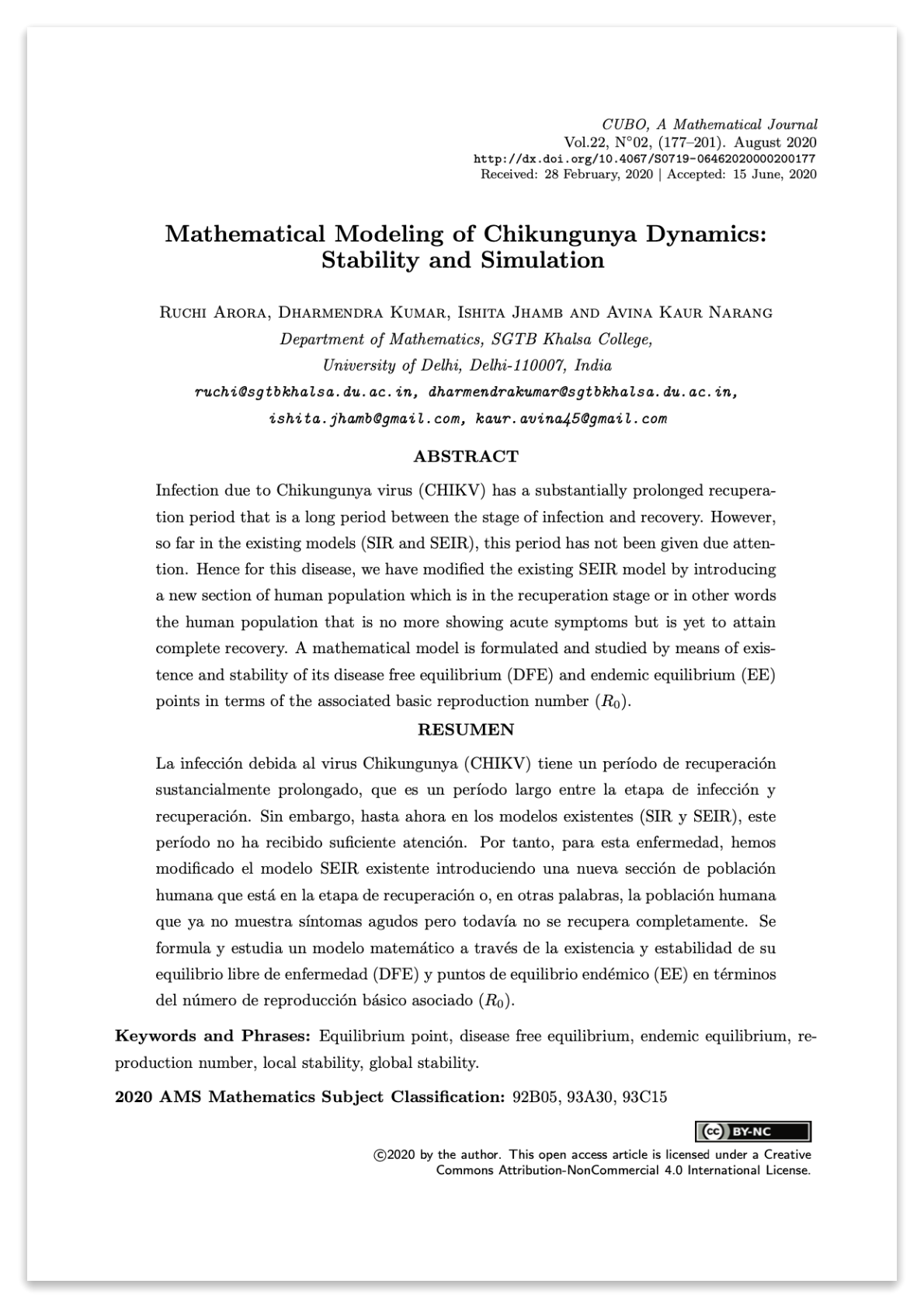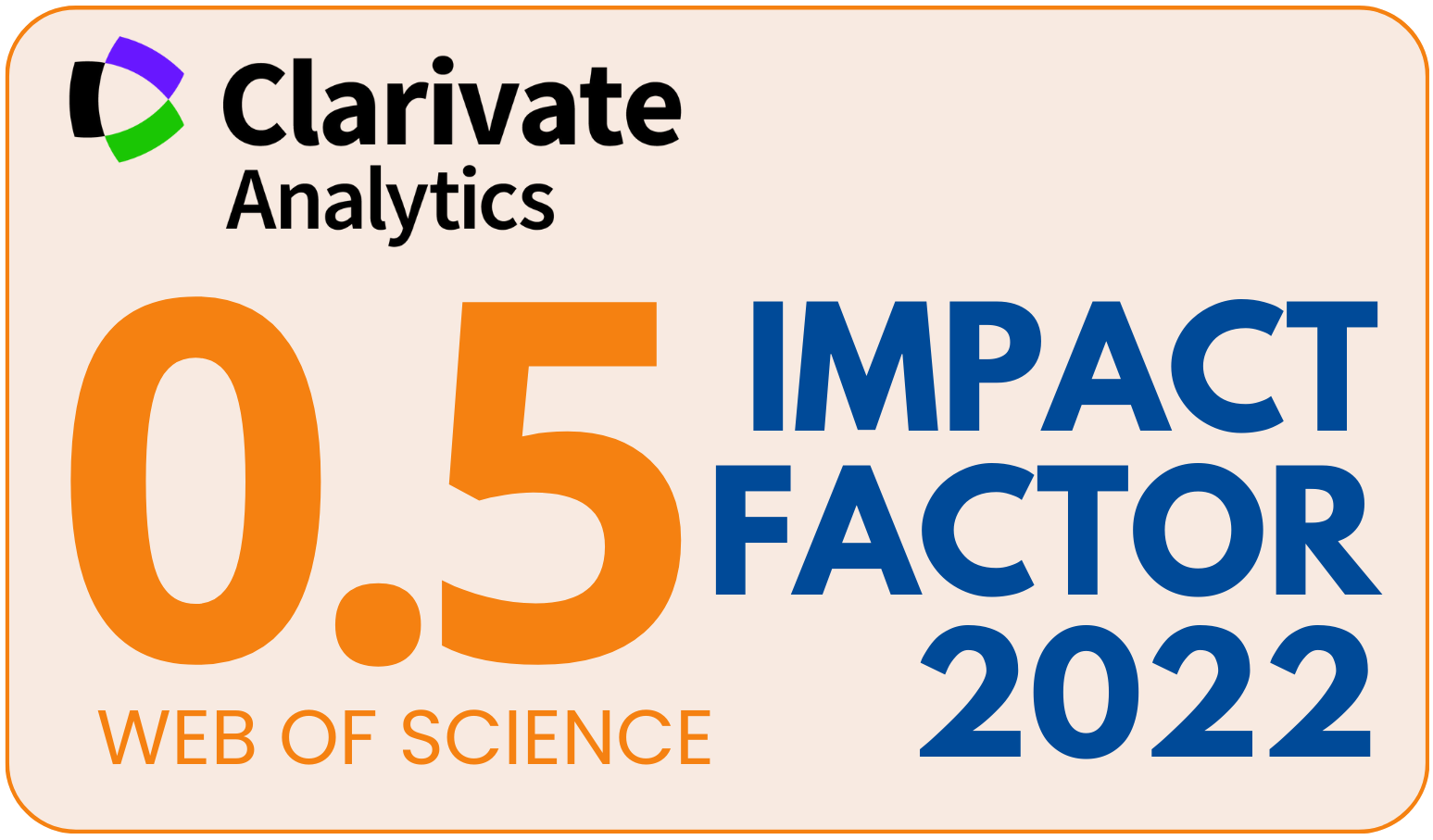Mathematical Modeling of Chikungunya Dynamics: Stability and Simulation
-
Ruchi Arora
 ruchi@sgtbkhalsa.du.ac.in
ruchi@sgtbkhalsa.du.ac.in
-
Dharmendra Kumar
 dharmendrakumar@sgtbkhalsa.du.ac.in
dharmendrakumar@sgtbkhalsa.du.ac.in
-
Ishita Jhamb
 ishita.jhamb@gmail.com
ishita.jhamb@gmail.com
-
Avina Kaur Narang
 kaur.avina45@gmail.com
kaur.avina45@gmail.com
Downloads
DOI:
https://doi.org/10.4067/S0719-06462020000200177Abstract
Infection due to Chikungunya virus (CHIKV) has a substantially prolonged recuperation period that is a long period between the stage of infection and recovery. However, so far in the existing models (SIR and SEIR), this period has not been given due attention. Hence for this disease, we have modified the existing SEIR model by introducing a new section of human population which is in the recuperation stage or in other words the human population that is no more showing acute symptoms but is yet to attain complete recovery. A mathematical model is formulated and studied by means of existence and stability of its disease free equilibrium (DFE) and endemic equilibrium (EE) points in terms of the associated basic reproduction number \((R_0)\).
Keywords
WHO. Chikungunya. http://www.who.int/denguecontrol/arbo-viral/other aborvial chikun gunya/en/, 2014.
WHO. Chikungunya. http://www.who.int/mediacentre/factsheets/fs327/en/, 2014.
National Center for Biotechnology information. Chikungunya outbreak. http://www.ncbl.nlm.nih.gov/pmc/atricles/PMC4111161, 2014.
G. Pialoux, B. Gäuz`ere, S. Jauréguiberry, and M. Strobel, Chikungunya, an epidemic arbovirosis. The Lancet infectious diseases, 7:319–27, 06 2007.
K. Sergon, C. Njuguna, R. Kalani, V. Ofula, C. Onyango, L. Konongoi, S. Bedno, H. Burke, A. M. Dumilla, J. Konde, M. Kariuki Njenga, R. Sang, and R. Breiman. Seroprevalence of chikungunya virus (chikv) infection on lamu island, kenya, october 2004. The American journal of tropical medicine and hygiene, 78:333–7, 03 2008.
M. Barro, A. Guiro and D. Ouedraogo, Optimal control of a SIR epidemic model with general incidence function and a time delays, Cubo 20 (2018), no. 2, 53–66.
O.K. Oare, Impact and optimal control of movement on a multipatch hepatitis C virus model, TWMS J. Pure Appl. Math. 5 (2014), no. 1, 80–95.
Y. Dumont, F. Chiroleu and C. Domerg, On a temporal model for the Chikungunya disease: modeling, theory and numerics, Math. Biosci. 213 (2008), no. 1, 80–91.
D. Moulay, M. A. Aziz-Alaoui and M. Cadivel, The chikungunya disease: modeling, vector and transmission global dynamics, Math. Biosci. 229 (2011), no. 1, 50–63.
L. Yakob and A. C. A. Clements. A mathematical model of chikungunya dynamics and control: The major epidemic on reunion island. PloS one, 8:e57448, 03 2013.
S. Naowarat and I. M. Tang. Transmission model of chikungunya fever in the presence of two species of aedes mosquitoes. American Journal of Applied Sciences, 10:449–459, 05, 2013.
D. Hincapie-Palacio and J. Ospina. Mathematical modeling of chikungunya fever control. page 948-70Z, 05 2015.
F. B. Agusto et al., Mathematical model of three age-structured transmission dynamics of Chikungunya virus, Comput. Math. Methods Med. 2016, Art. ID 4320514, 31 pp.
A. Mohan, D. H. N. Kiran, I. Chiranjeevi Manohar, and D. Prabath Kumar. Epidemiology, clinical manifestations, and diagnosis of chikungunya fever: Lessons learned from the re-emerging epidemic. Indian journal of dermatology, 55:54–63, 01 2010.
C. Manore, K. Hickmann, S. Xu, H. Wearing, and J. Hyman. Comparing dengue and chikungunya emergence and endemic transmission in a. aegypti and a. albopictus. Journal of Theoretical Biology, 356:174-191, 09 2014.
N. Chitnis, J. M. Hyman and J. M. Cushing, Determining important parameters in the spread of malaria through the sensitivity analysis of a mathematical model, Bull. Math. Biol. 70 (2008), no. 5, 1272–1296.
H. Delatte, G. Gimonneau, A. Triboire, and D. Fontenille. Influence of temperature on immature development, survival, longevity, fecundity, and gonotrophic cycles of aedes albopictus, vector of chikungunya and dengue in the indian ocean. Journal of medical entomology, 46:33– 41, 02 2009.
Y. Dumont and F. Chiroleu, Vector control for the Chikungunya disease, Math. Biosci. Eng. 7 (2010), no. 2, 313–345.
C. Lahariya and S. Pradhan. Emergence of chikungunya virus in indian subcontinent after 32 years: A review. Journal of vector borne diseases, 43:151–60, 01 2007.
M. R. Sebastian, R. Lodha, and S. Kabra. Chikungunya infection in children. The Indian Journal of Pediatrics, 76:185–89, 03 2009.
O. Schwartz and M. Albert. Biology and pathogenesis of chikungunya virus. nat rev microbiol 8: 491-500. Nature reviews. Microbiology, 8:491–500, 07 2010.
K. Costanzo, K. Mormann, and S. Juliano. Asymmetrical competition and patterns of abundance of aedes albopictus and culex pipiens (diptera: Culicidae). Journal of medical entomology, 42:559–70, 08 2005.
N. A. Hashim, A. Hassan, O. N. Abu Tahir, M. Salmah, and N. Basari. Population analysis of aedes albopictus (skuse) (diptera:culicidae) under uncontrolled laboratory conditions. Tropical biomedicine, 25:117–25, 09 2008.
M. Dubrulle, L. Mousson, S. Moutailler, M. Vazeille, and A. B. Failloux. Chikungunya virus and aedes mosquitoes: Saliva is infectious as soon as two days after oral infection. PloS one, 4:e5895, 02 2009.
D. Mavalankar, P. Shastri, T. Bandyopadhyay, J. Parmar, and K. Ramani. Increased mortality rate associated with chikungunya epidemic, ahmedabad, india. Emerging infectious diseases, 14:412–5, 04 2008.
P. Poletti, G. Messeri, M. Ajelli, R. Vallorani, C. Rizzo, and S. Merler. Transmission potential of chikungunya virus and control measures: The case of italy. PloS one, 6:e18860, 05 2011.
M. Turell, J. R. Beaman, and R. F. Tammariello. Susceptibility of selected strains of aedes aegypti and aedes albopictus (diptera: Culicidae) to chikungunya virus. Journal of medical entomology, 29:49–53, 02 1992.
E. Massad, S. Ma, M. Burattini, Y. Tun, F. Coutinho, and L. Ang. The risk of chikungunya fever in a dengue endemic area. Journal of travel medicine, 15:147–55, 05 2008.
K. Pesko, C. J. Westbrook, C. Mores, L. Philip Lounibos, and M. Reiskind. Effects of infectious virus dose and bloodmeal delivery method on susceptibility of aedes aegypti and aedes albopictus to chikungunya virus. Journal of medical entomology, 46:395–9, 04 2009.
V. Lakshmikantham, S. Leela, and A.A. Martynyuk. Stability Analysis of Nonlinear Systems. Systems & Control: Foundations & Applications. Springer International Publishing, 2015.
P. van den Driessche and J. Watmough, Reproduction numbers and sub-threshold endemic equilibria for compartmental models of disease transmission, Math. Biosci. 180 (2002), 29–48.
J. H. Jones. Notes on r0. Department of Anthropological Sciences Stanford University, 2007.
G.F. Simmons. Differential Equations with Applications and Historical Notes. Textbooks in Mathematics. CRC Press, 2016.
C. Bhunu, W. Garira, and Z. Mukandavire. Modeling hiv/aids and tuberculosis coinfection. Bulletin of mathematical biology, 71:1745–80, 06 2009.
C. Castillo-Chavez, Z. Feng and W. Huang, “On the Computation of R0 and Its Role on Global Stability” In: Mathematical Approaches for Emerging and Reemerging Infectious Diseases: An Introduction, Springer-Verlag, New York, 2002, pp. 229-250.
EX. DeJesus and C. Kaufman. Routh-hurwitz criterion in the examination of eigenvalues of a system of nonlinear ordinary differential equations. Physical review. A, 35:5288–5290, 07 1987.














